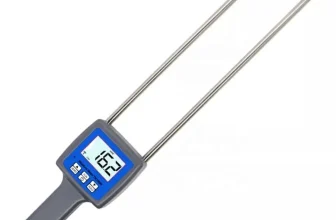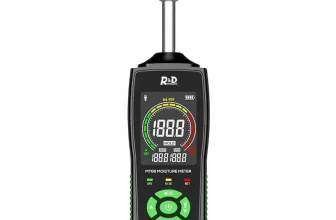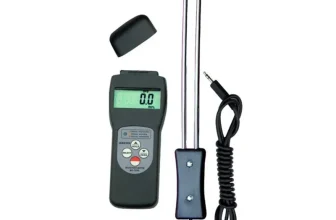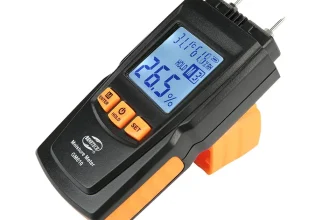A moisture reader for drywall, often referred to as a moisture meter,
is a handy tool that helps in detecting and quantifying the moisture
content within drywall. This device, like a household essential for any
homeowner or a must-have in the toolkit of contractors, inspects the
drywall’s moisture level, indicating whether it’s dry, has mild
dampness, or is severely wet. Using innovative science and technology,
moisture readers ensure that your drywall’s health is always in check,
serving as a preventative measure against potential damage that could
otherwise go unnoticed.
Discuss the
importance and uses of moisture readers
Understanding the moisture levels in drywall is extremely significant
for a variety of reasons, and this is where moisture readers come handy.
These little tools serve a crucial role in preventing moisture-related
issues that may compromise the structural integrity of a building or
house.
First and foremost, moisture readers help in detecting any hidden
water damage. Used commonly by construction professionals, home
inspectors, and even DIY homeowners, these meters serve as an early
warning system for potential moisture problems.
They are especially useful in assessing newly built constructions or
in pre-buying home inspections, enabling users to identify potential
issues that may not be immediately visible. Even in homes or buildings
not prone to flooding or obvious water damage, moisture readers can help
track small leaks before they become a big problem.
Another key use of these robust little devices is in the management
of mold growth. Mold, a common outcome of excessive moisture, poses
significant health risks. By using a moisture reader, you can detect if
the condition of your drywall is ripe for mold growth, allowing you to
manage the situation promptly.
These tools also play a significant role in the renovation and
painting industries. By determining the dryness of a wall, they can help
ensure that paint or wallpaper adheres properly or that plaster doesn’t
prematurely dry out and crack.
Essentially, the adoption of moisture readers paves the way to
comprehensive and effective drywall maintenance, by taking the guesswork
out of identifying potential moisture-related issues.
Types of Moisture Readers
for Drywall
Pin-Type Moisture Readers
Detailed explanation and
pros and cons
Pin-Type Moisture Readers, also known as intrusive moisture meters,
are popular tools for detecting moisture in drywall. These devices come
with two sharp pins that are designed to be inserted into the material.
When these pins are driven into the drywall, they send an electrical
signal between them, estimating the moisture content based on the
conductivity of the material.
Advantages of Pin-Type Moisture Readers:
- Accurate Readings: Pin-type moisture meters typically provide
more precise, reliable, and consistent moisture readings. This is
because they physically penetrate the material and test the resistance
amongst the pins, allowing for an accurate assessment of moisture
concentration. - Different Depth Readings: One advantage of this type of moisture
reader is the ability to gauge moisture at different depths. By varying
the depth of pin insertion, you can assess surface-level moisture or
further within the drywall.
Disadvantages of Pin-Type Moisture Readers:
- Cause Physical Damage: A prominent drawback of these meters is
that they cause physical damage to the wall or material being tested,
leaving small holes that may need to be patched. - Material Limitations: These readers can also struggle to provide
accurate readings on hard surfaces or materials where it’s challenging
to drive in the pins.
In conclusion, pin-type moisture readers are a robust and precise
tool for identifying moisture in drywall. Despite a few downsides
related to physical damage and material limitations, they nevertheless
deliver in-depth insights invaluable when seeking to detect and mitigate
dampness issues.
Pinless Moisture Readers
Detailed explanation
and pros and cons
Pinless moisture readers, also known as non-invasive or
non-destructive moisture readers, offer a damage-free method of
detecting moisture levels in drywall. These devices use radio or
electromagnetic waves to measure moisture content and provide quick and
easy readings with impressive accuracy.
One significant advantage of pinless moisture readers is that they
are non-invasive. This means they do not create holes or marks on your
drywall, which is particularly beneficial if you’re dealing with visible
surfaces or finished products. These readers give instant readings and
reveal moisture content across a large area, enabling you to detect
moisture hot-spots fast.
While this sounds ideal, pinless readers also have some drawbacks.
They may be less accurate on thick or dense materials cut with heavy
textures or irregularities, as these factors can sometimes interfere
with the sensor. Furthermore, some models of these readers might not be
able to differentiate between materials behind the drywall and may give
false readings if there are pipes or metallic objects present. Lastly,
to get accurate readings, the surface of the wall must be flat and
undamaged to ensure full contact with the sensor.
In summary, while pinless moisture readers are a fantastic tool for
detecting moisture without marking surfaces, they could be less precise
on uneven surfaces and around metallic objects and may require a flat
and intact surface for accurate readings.
How Moisture Readers Work
The science behind
measuring moisture levels
Moisture readers for drywall use the principle of electrical
resistance or dielectric constant to measure moisture content. Here’s
how they work:
The science behind these devices is quite fascinating. Electricity
travels differently through wet and dry material. This variation in
conduction is what a moisture reader measures to determine the moisture
content.
Pin-type moisture meters, for instance, work based on electrical
resistance. They have two pins, which, when inserted into the drywall,
act as the ‘terminals’ of an electrical circuit. The moisture reader
sends a small electrical current from one point to another. Moisture
acts as a conductor for electricity. Hence, if the drywall is damp,
electrical resistance will be less, allowing the current to flow more
freely between the two points. Conversely, if the drywall is dry,
resistance will be higher, and the current will face more difficulty
getting through. The meter then reads the strength of the current
passing through the drywall and converts this into a moisture content
reading.
On the other hand, Pinless moisture meters work on the principle of a
dielectric constant. A pinless meter radiates a low-frequency signal
into the material being tested, and then measures the response by
detecting changes in the signal’s capacitance or loss factor. The
changes represent the amount of moisture in the material. These meters
are non-invasive, meaning they won’t cause damage to your drywall.
By understanding the science behind how moisture readers work, we can
more effectively use them to keep out drywall in optimum condition.
The
difference in function between pin-type and pinless readers
Both pin-type and pinless moisture readers do a phenomenal job of
sensing moisture in drywall; however, they function in slightly
different ways.
Pin-type moisture readers measure resistance to judge the level of
moisture. They use two pins that are inserted directly into the
material. Electricity is passed between the pins and the reader gauges
how much resistance the current encounters. The more moisture in the
material, the less resistance experienced because water is a good
conductor of electricity. This makes the pin-type moisture reader
precise for detecting exact areas of moisture.
On the other hand, pinless moisture readers use sensor pads that you
place against the drywall. These sensors create an electromagnetic field
that can detect varying degrees of moisture without causing any damage
to the surface. This method responds to changes in the material’s
ability to hold an electrical charge, known as its capacitance. In
wetter materials, more charge builds up, which can be detected by the
sensor.
While both readers detect moisture, the pinless readers are generally
more suited to scanning larger areas quickly and are non-invasive, while
pin readers provide more precise readings and can reach deeper into
materials. Given these differences, it’s crucial to understand the
unique features of each tool and select the one that best meets your
specific needs.
Why You Need a
Moisture Reader for Drywall
Signs of excessive moisture
When it comes to signs of excessive moisture in your drywall, there
are several symptoms to watch out for. The first, and most obvious, is
the presence of damp spots or visible mold growth on the surface of the
wall. These are telltale signs that there is a significant amount of
moisture present within the drywall.
Another symptom to watch out for is a persistent musty odor. This can
be an indication of hidden mold growth, which is often caused by
excessive moisture trapped inside the drywall. Similarly, persistent
allergies or other unexplained health issues can also be a sign of
hidden mold growth and excess moisture.
In some cases, you may also notice changes in the texture of the
drywall itself. The wall might feel soft or spongy to the touch, or you
may observe warping, buckling or cracking in the drywall. Paint might
peel off or wallpaper might start to loosen due to the moisture
weakening the bond between the wall and the outer layer.
Additionally, you might notice condensation on the surface of the
wall, especially during colder weather. This can be an indication of
high humidity levels inside the wall, which can lead to excessive
moisture.
Lastly, your drywall might acquire a faded, stained, or unusually
dark color, often resulting from the type of moisture-related damage
known as “wet spots”.
All these symptoms point towards a need for a moisture reader. A
timely and accurate moisture measurement can help to avoid significant
damage and potential health issues, enabling you to take corrective
action as needed.
Potential
issues caused by excessive moisture (mold, structural damage etc.)
Excessive moisture within drywall can lead to numerous issues that
pose both health and structural risks. One of the most common problems
is the growth of mold. Mold thrives in moist conditions and can rapidly
spread within the damp regions of drywall. Not only does mold damage the
look of the wall, but it also poses serious health risks. Prolonged
exposure to mold spores can lead to respiratory problems, allergic
reactions and other health issues.
In addition to mold, excessive moisture may lead to structural damage
as well. When drywall absorbs moisture, it becomes soft and starts to
break down, compromising its integrity. Over time, this can lead to
warping or buckling, causing severe damage that requires costly repairs
or replacement. In extreme cases, consistent dampness may even
compromise the stability of the entire wall or structure.
Another potential concern is the attraction of pests. Damp
environments serve as ideal breeding grounds for various insects, bugs,
and rodents, leading to infestations that can further damage your
property and cause health concerns.
These potential issues underscore the necessity of a moisture reader
for drywall. By accurately identifying areas with excess moisture, you
can address the problem early on and prevent these costly and harmful
consequences.
How to Use a Moisture
Reader for Drywall
Step by step
process for using a moisture reader
Using a moisture reader on drywall is relatively straightforward and
does not require expertise. Here’s a straightforward guide:
- First, ensure your moisture reader is properly calibrated
according to the instructions provided by the manufacturer. - If using a pin-type moisture reader, insert the pins into the
drywall. The depth of penetration will vary depending on the specific
tool and drywall thickness. For a pinless meter, however, place the
sensor side against the wall. - Turn on the moisture reader. These devices typically have simple,
user friendly interfaces. - Read the display. If using a digital reader, the moisture level
will be displayed numerically. Some readers may use color codes or alarm
sounds to signify different levels of moisture. - Take multiple readings in different locations for a comprehensive
view of moisture distribution. Depending on your reader, you may also
need to take multiple readings at different depths within the
drywall. - Record these readings for future reference, especially if you’re
going to compare moisture levels over time.
That’s it. Regularly taking readings from different parts of your
wall will help you identify problem areas early and take appropriate
action. Always refer to your device’s manual for more detailed
instructions or precision adjustments.
Interpreting moisture
reader results
Interpreting the results from a moisture reader for drywall is
straightforward once familiar with the scale used by the specific
device. Most moisture readers offer a percentage readout in their
display, representing the approximate moisture content of the
material.
In general, drywall is considered dry if the moisture content is 12%
or less. If the readings are persistently above this threshold, it may
indicate excess moisture. Here are some guidelines for interpreting
moisture meter readings for drywall:
- 0% – 10%: These readings generally indicate that the drywall is dry.
This is the ideal moisture level range for drywall. - 11% – 15%: These readings suggest that the drywall might be slightly
moist. Some inspection may be necessary to determine if moisture might
be a problem. - 16% – 20%: These readings indicate that the drywall is at risk.
Active measures must be taken to reduce moisture and prevent
damage. - Above 20%: This is typically considered a very high moisture content
level for drywall. It suggests presence of water intrusion and risks of
structural damage and mold growth.
Remember, it is crucial to take readings from multiple points on the
wall, as drywall can dry unevenly and might be more damp in certain
places. Higher readings near pipes or windows may suggest a specific
source of moisture intrusion to address.
It is also worth noting that moisture meter readings should primarily
be used as a tool for comparison and less as an absolute measurement. If
there’s a noticeable difference between readings taken from a known dry
area and the area suspected of excess moisture, this is a strong
indicator of a moisture issue.
Top Moisture
Readers for Drywall in the Market
Overview of top rated
products
Choosing the right moisture reader for drywall can be a game-changer
when it comes to home renovation and improvement projects. Several
top-rated moisture readers are recommended by professionals due to their
sophisticated features, accuracy, and heavy-duty performance.
The Protimeter Surveymaster is a top-notch choice, recognized for its
dual function of both pin and pinless moisture reading features. The
pinless mode is ideal for non-invasive detection and quick scanning of a
large area, while the pin mode offers more precision and indicates the
exact moisture content.
Next is the Tramex MEP Moisture Encounter Plus, a non-invasive
moisture meter that allows for quick, broad assessments. This meter has
been lauded for its reliability, and the ability to detect moisture up
to one inch below the surface.
The Lignomat Scanner SD Moisture Meter stands out for its
versatility, having a reference scale for building materials that
extends beyond drywall. It sets itself apart with an adjustable alarm
setting, alerting you when moisture levels are higher than
preferable.
Lastly, the DeWalt-Non-contact-Moisture Meter commands attention for
its user-friendly operation and spot-on accuracy. Its ability to detect
moisture without causing damage to the surface, along with its intuitive
interface and easy-to-read LED display, make it an excellent choice for
both professionals and DIY enthusiasts.
These are just a few options in the vast landscape of moisture
readers for drywall. Whatever your needs, there’s likely a product that
meets them. The most important features to consider are accuracy, ease
of use, versatility, and the type of moisture reading technology (pin or
pinless) that best fits your project.
Brief review of each
recommended product
- General Tools MMD4E Moisture Meter: This is a simple,
user-friendly tool that boasts a bright and easily readable display. It
offers accurate readings and has an alarm that sounds when moisture
levels are too high. The MMD4E is ideal for DIY enthusiasts and
professionals who need a reliable handheld device. - Wagner Meters Orion 950 Smart Pinless Wood Moisture Meter: The
Orion 950 is a premium, high-quality option for those who need top-notch
accuracy. It provides quick, precise measurements without pins that
might mar the surface of your drywall. It’s a bit pricey, but the
exceptional performance and built-in temperature and humidity meter make
it a worthwhile investment. - Dr.meter Intelligent Moisture Meter: This pinless model is ideal
for scanning large areas of drywall quickly. Plus, its high frequency
sensing technology provides accurate readings at varying depth levels.
This meter also boasts a wide measurement range and a backlit display
that ensures easy reading under different lighting conditions. - Protimeter BLD5365 Surveymaster Dual-Function Moisture Meter:
This moisture meter is fantastic for those who want the versatility of
both pin and pinless readings. The BLD5365 offers deep signal
penetration up to 1 1/2 inches, making it especially adept at tracking
moisture in drywall. - RISEPRO Digital Moisture Meter: The RISEPRO is an affordable
choice that doesn’t skimp on performance. It provides both pin and
pinless measurements, making it highly versatile. It also comes with a
protective cap for the pins to ensure their durability over
time. - Tavool Wood and Drywall Moisture Meter: This 2-in-1 pin-type and
pinless meter is praised for its accuracy. Its clear LED display makes
it easy to get a reading, and it even includes an auto power off feature
to conserve battery life. With seven different types of material
settings, you can easily adjust to get the most accurate readings for
your specific type of drywall.
Maintaining Your Moisture
Reader
Tips for proper cleaning
and storage
Ensuring the longevity and accuracy of your moisture reader involves
a few simple upkeep practices. First and foremost, it’s critical to keep
your device clean. After each use, wipe the surface of the reader,
especially the pins or pad, with a soft, dry cloth to remove any dust or
residue. If the device is heavily soiled, a damp cloth can be used, but
be cautious not to let any moisture seep into the internal parts as it
could hamper its functionality.
For storage, always keep your moisture reader in a cool, dry place.
Protect it further by storing it in a case or bag to guard against dust
and accidental damage. Some models come with their own hard case; if
yours does not, consider investing in one. Another tip is to remove the
batteries if you’re not going to use the device for a while – this
prevents any potential corrosion damage.
Lastly, be gentle with the device, particularly if you have a
pin-type model. The pins can be delicate and may bend or break if
mishandled, which could lead to inaccurate readings. Also avoid dropping
or shock as this could damage the internal electronics.
Importance
of calibrating your moisture reader regularly
Regular calibration of your moisture reader is crucial for its
overall performance and accuracy. Calibration ensures that your device
is correctly measuring moisture levels in your drywall, providing you
with reliable data to base decisions upon.
Firstly, it’s important to understand that over time, the internal
components of a moisture reader can drift from their original
specifications. This is a normal occurrence that can be significantly
influenced by frequent uses, drops or knocks, exposure to high or low
temperatures and more.
When this drift occurs, it causes your readings to become inaccurate,
which can lead to misinterpretations of the condition of your drywall.
For instance, you could assume that your wall is dry when it actually
has high moisture content, or vice versa. These incorrect readings can
hinder your efforts to maintain the quality and longevity of your
space.
Furthermore, regular calibration is necessary to meet the designated
industry standards. These standards are implemented to ensure uniformity
and reliability of measurement results across different devices and
users.
Another key point to note is that some manufacturers require regular
calibration as part of their warranty terms. Failure to do so could void
your warranty, leaving you responsible for any repair or replacement
costs.
In a nutshell, to boost your confidence in the readings you receive –
and to minimize the risk of misdiagnosis – it is vitally important to
routinely calibrate your moisture reader. A small investment of time can
potentially save you costly repairs and unnecessary headaches in the
future.
Conclusion
Recap
of the importance and uses of moisture readers for drywall
Throughout this article, the significant role of moisture readers for
drywall has been underscored. These valuable tools are essential for any
homeowner, contractor, or inspector looking to ensure the structural
integrity and longevity of drywalls in a building. Not only do they
detect early signs of potentially dangerous moisture buildup, but they
can also prevent expensive repairs caused by untreated water damage.
Their versatility allows them to be used in assessing construction
sites, home renovations, or regular home maintenance. The two kinds,
pin-type and pinless, each present interesting pros and cons that make
them suitable for various circumstances.
Routine use of moisture readers and correctly interpreting their
results can serve as a preventive measure against structural damage and
health issues like mold and mildew. Furthermore, there are several
high-performing options available in the market, so acquiring one that
fits your budget and requirement is a feasible task.
Just as maintaining drywall is important, so too is the upkeep of
your moisture reader, as it ensures accuracy and prolongs the tool’s
lifespan. Remember to keep it clean and recalibrate it regularly.
Choosing the appropriate moisture reader will largely depend on your
specific needs and budget, but one thing remains undeniable: owning a
moisture reader is a pivotal investment in preserving the health of your
home or building. Their crucial role in maintaining drywall cannot be
overstated.
Final
advice on choosing and maintaining a moisture reader.
Choosing the right moisture reader for drywall depends primarily on
your specific needs and the nature of the tasks at hand. Take into
consideration the property you will be using it on, the amount of usage
it will get, and the specific features you need, like accuracy,
durability, and user-friendly design. Some professionals might prefer
pin-type readers for their accuracy, while homeowners might value the
non-destructive method of pinless readers.
Maintenance of your moisture reader is as crucial as its selection.
Treat it with care, as you would any professional tool. Clean it gently
after each use, store in a dry and secure place and remember to
calibrate it as per manufacturer’s instructions or at least annually for
optimum functionality and precise readings.
Your attention to these few yet vital aspects can go a long way in
enhancing the life and effectiveness of your moisture reader, ensuring
that it remains a reliable partner in safeguarding your property’s
drywall from moisture- related issues.







